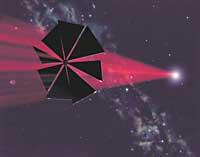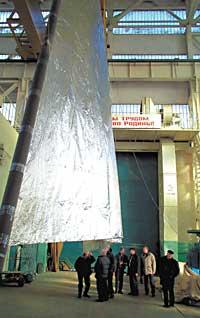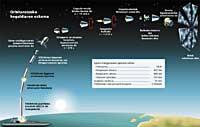In space to a bolina
Solar sailboat?

Conventional spacecraft are powered by fuel that burns in an internal combustion engine, work that makes sunlight on solar sailboats.
Light is not pure wave, remember Broglie! Photons also act as particles. Therefore, when light strikes on a mirror-like surface, photons are reflected in the way the ball acts on the wall of the pediment. In this process the photons transfer a quantity of movement to the surface. It is extremely small, but due to the infinite shock of photons, the surface begins to move forward. This surface, in short, behaves like a candle.

Therefore, if we supply a capsule to carry the load with a proper sailing system, we can travel in the cheap space and without the need for gas station. In fact, as in the case of sailboats sailing the oceans, it is possible to control the speed and direction of the vessel through an adequate orientation of the sail with respect to the light source. And to race!
Not everything is a beech. Sunlight provides the container with very low acceleration. For example, a 600,000 square meter candle, equivalent to about 60 football fields, would only reach a speed of one millimeter per second in interplanetary space. For example, the acceleration of a mission on Mars can be 59 meters per second when launching Delta II rockets: 59,000 times bigger! However, the acceleration of sunlight is continuous and that of the rocket lasts a few minutes, while the fuel lasts, until reaching the speed of crossing the road. The speed of the sail described would be 310 kilometers per hour in one day and 3,700 kilometers per hour in 12 days.

On the other hand, conventional probes and spacecraft have to carry fuel to perform spatial maneuvers, such as gaining orbital altitude or changing direction. This leaves room for loading or transporting scientific instruments. This would not happen in the case of a sailboat, since it would be the force of light that would be the ‘fuel’ for these maneuvers, which would allow a greater load capacity with the same weight.
Cosmos 1
This mission is a project promoted and promoted by the Association The Planetary Society (www.planetary.org) that aims to demonstrate the viability of solar sailboats. This association has sought the necessary funding and has collaborated with various Russian scientific institutions.
Kosmos 1 has been launched on March 1 from a Russian submarine in the Barents Sea via a Volna rocket. At first it is facing the Pacific at 825 kilometers of altitude. It will use the force of the batteries to obtain energy and in the meantime will open solar panels for energy collection. During the first days, our pioneer will carry the collected candles, while the systems work properly.

Then the hour H will come when Kosmos 1 orbite by the pair Moscow. A set of four triangular candles begins to unfold. If everything goes well, the second group will also open. It is possible that those who are controlling the mission decide to expand the second group in the next orbit. Then and only then will it become a sailboat Kosmos 1. The first days the candles will be left in a fixed position, will not turn to change speed or direction. After a few days, the candles will begin to move and, taking an appropriate angle, will increase the speed of the container to transfer to a higher orbit.
What will happen next is not clear, technicians do not know exactly. The metallic plastic that forms the candle begins to degrade in a month. By then it is possible that the Earth has reached an orbit of enough altitude to perpetuate itself, but probably the altitude of the orbit will be lost and, converted into a fireball, like a shooting star, will burn through the atmosphere. Who sees it?
The dates provided after sending the magazine to the press may be modified.
Solar navigation

How to govern the solar sailboat? In the sea, the sailboats are governed by combining the force of the wind on the sail and the friction of the water on the hull. For in space, similarly, sunlight exerts the action of the wind and the orbital speed of the water vessel. Therefore, it will be governed by changing the angle of the solar candle with respect to light. By changing the angle, the boat exerts a force perpendicular to the sail, changing its speed and direction. If the speed increases, the boat will go outward, but if it decreases inward.
Unlike rockets, the change of direction is not a sharp process, but continuous. The route, instead of having an elliptical aspect, is a spiral. This is a succession of ellipses in constant change.
Space Regattas

Like many other ideas, Arthur C. Clark was in charge of giving smallpox to solar sailboats. He was not the first to bring solar candles to the world of fiction, as Cordwainer Smith mentioned before The lady Who Sailored The Soul in his short novel, but the solar yacht regatta from the orbit of the Earth to the Moon and the surprising details about navigation surprised readers' imagination ( Sunjammer, 19642). Another great science fiction writer, Poul Anderson, used solar ships in a story to bring chemicals to Earth from the asteroid belt (also called Sunjammer).
However, Jules Verne suggested that the force of light could be used to navigate space through a character from the well-known novel From Earth to the Moon (1865).
The first to arrive at Seiroski were Konstantin Tsiolkovski, a Russian physicist pioneer in many other fields of space exploration, and his assistant was the Latvian Fridrih Arturovitx Tsander. His ideas, unlike liquid fuel rockets, had no echo.
Paradoxically, it was published in a science fiction magazine. First serious approach to the solar veils of the postwar world. In Astoundig Science Fiction, in a nonfiction article, an engineer named Clipper Ships of Space, Russell Saunders, with a pseudonym, explained in detail how candles could be formed in orbit and used to navigate. It was in 1951.
- The lady who traveled in ‘The Soul’, New Dimension, 22. nº 1971.
- The wind of the sun. Spatial Age Stories, Alliance ed., 1987.
- The original was published in Analósis Science Fact/ Science Fiction in April 1964. I have not found any version in Spanish or French.






